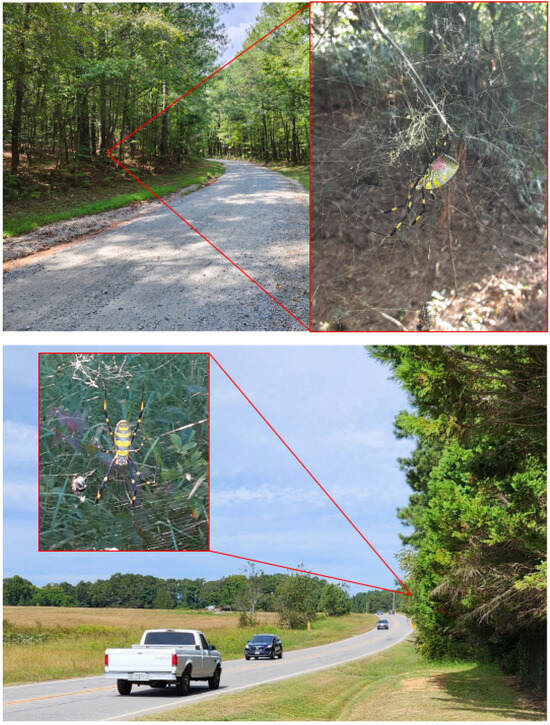2024-02-13 ジョージア大学 (UGA)
◆研究者たちは、交通の多い道路近くに生息するジョロウクモの攻撃行動を調査し、その結果、繁忙な道路近くにいるジョロウグモはやや攻撃率が低いものの、体重や健康には影響がないことが示された。これにより、ジョロウグモは都市環境に適応できることが示唆された。
◆ジョロウグモは東アジアに生息し、その耐性と繁殖力から米国で急速に増加しているが、彼らの広がりはそれほど心配することはない。
<関連情報>
- https://news.uga.edu/joro-spiders-poised-to-populate-cities/
- https://www.mdpi.com/2813-3323/2/1/4
- https://resjournals.onlinelibrary.wiley.com/doi/full/10.1111/phen.12385
ジョロウグモの都市耐性は?ジョロウグモ(Trichonephila clavata)の獲物捕獲行動を繁華な道路沿いでテストする How Urban-Tolerant Are They? Testing Prey–Capture Behavior of Introduced Jorō Spiders (Trichonephila clavata) Next to Busy Roads
Andrew K. Davis,Kade Stewart,Caitlin Phelanand Alexa Schultz
Arthropoda Published: 13 February 2024
DOI:https://doi.org/10.3390/arthropoda2010004

Abstract
An invasive orb-weaving spider from east Asia is now spreading through the southeastern United States; Trichonephila clavata (the “jorō spider”) makes large, imposing webs seemingly everywhere, including in urban landscapes, and even next to busy roads. However, areas near roads come with frequent disturbances, including auditory and vibrational, which for many animals, leads to physiological or behavioral changes. Here we tested if varying levels of road traffic affect the prey–capture behavior of jorō spiders in northeast Georgia. We visited roadsides that ranged in traffic density and exposed nearby jorō spiders to a simulated prey (a tuning fork at 128 hz frequency, touched to the web), and recorded whether or not the spider attacked it. Out of 357 total trials across 20 different roads, jorō spiders attacked the simulated prey 59% of the time, but at the local scale, there was high variability in this rate; at some roadsides, over 80% of the spiders attacked, while at others, less than 30% did. When all roads were considered collectively, there was a small but significant (negative) correlation between daily road traffic and spider attack rates. Put another way, spiders near moderate- to heavy-traffic roads were slightly less likely to attack than those near low-traffic roads (51% vs. 65%). Jorō spiders appear to be able to live near roads, but this does come with a cost in terms of prey capture. However, spiders near busier roads did not weigh less than those in other sites, suggesting they may be able to compensate for the disturbance. These findings add to the accumulating evidence around this species that points to its ability to exist in human-dominated landscapes, which will likely aid its spread in the introduced range.
アメリカ南東部に新たに侵入したジョロウグモ(Trichonephila clavata)の生理学的評価と帰化した同属種Trichonephila clavipesとの比較 Physiological evaluation of newly invasive jorō spiders (Trichonephila clavata) in the southeastern USA compared to their naturalized cousin, Trichonephila clavipes
Andrew K. Davis, Benjamin L. Frick
Physiological Entomology Published: 17 February 2022
DOI:https://doi.org/10.1111/phen.12385

Abstract
A newly-invasive spider from east Asia, Trichonephila clavata, or “jorō spider”, is spreading in the southeastern United States. Little is known about the biology or physiology of this species in this new range. Interestingly, a closely-related species in the same genus, the “golden silk spider,” Trichonephila clavipes, is already successfully established in this same region over the last 160 years. The golden silk spider, which is native to the tropics, has not expanded its range beyond the southeast, likely because of thermal limitations. This investigation is to determine how the biology and physiology of T. clavata compare to T. clavipes. We reason that if their physiologies are similar, then T. clavata would be similarly confined to the southeast. We examine online records submitted to iNaturalist.org to compare seasonal distributions and timing, and we collect females to measure physiological traits that help predict environmental tolerance, including metabolic rates, cardiac functioning (heart rate) during cold-exposure, and survival during brief (2 min) below-freezing temperature. Results show the jorō spider has a shorter season than its cousin, indicating it can complete its lifecycle within a narrow period of suitable weather. It has an inherently higher metabolism (twice as high), and has a 77% higher heart rate when exposed to low temperature. Finally, jorō spiders survive better (74% compared to 50%) in a brief freeze. These findings suggest the jorō spider can exist in a colder climatic region than the southeastern USA, which can be useful information for management or planning purposes.


